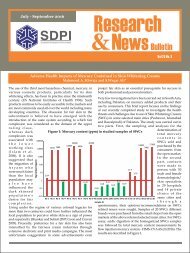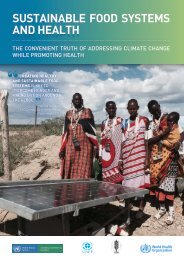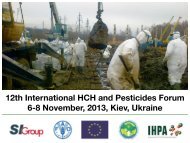Women and Chemicals
WomenAndChemicals_PublicationIWD2016
WomenAndChemicals_PublicationIWD2016
You also want an ePaper? Increase the reach of your titles
YUMPU automatically turns print PDFs into web optimized ePapers that Google loves.
Where are women exposed to chemicals?<br />
Example: African Horticulture 34<br />
Since two decades, the industry of horticulture<br />
<strong>and</strong> floriculture is becoming a huge working field for<br />
East Africans due to the dem<strong>and</strong> of the European market.<br />
While food safety is observed very strictly, the working conditions<br />
of the field workers is not the interest of European companies.<br />
The workers, a lot of them women, suffer from various working<br />
conditions, e.g. extremely low pay rates, absence of contracts, forced overtime,<br />
sexual harassments <strong>and</strong> poor health <strong>and</strong> safety conditions.<br />
In Ug<strong>and</strong>a for example, 227 pesticides are used in horticulture, some of them<br />
are even banned <strong>and</strong> highly toxic. In most of the farms, the workers do not get any<br />
training or awareness raising on pesticide hazards <strong>and</strong> appropriate behavior to avoid the<br />
direct exposure to these toxic chemicals. Some of the workers even were unaware of their<br />
toxic workplace <strong>and</strong> the long-term effects pesticides could cause on their health.<br />
A lot of farms do not provide their workers provision of appropriate personal<br />
protective equipment, which is an absolute prerequisite for anyone h<strong>and</strong>ling<br />
pesticides. The lack of boots <strong>and</strong> gloves is a high risk for workers in making<br />
them vulnerable to chemical penetration through the skin.<br />
From exposure of pesticides, chemical poisoning is not an<br />
exception in the daily life of the workers. Common disorders<br />
are miscarriages <strong>and</strong> irregular menstrual flow, skin irritation<br />
<strong>and</strong> burns, as well as upper respiratory tract<br />
problems.<br />
A survey of female rice farmers in Thail<strong>and</strong> found that<br />
women lack basic training in h<strong>and</strong>ling pesticides. Their husb<strong>and</strong>s,<br />
who were skilled using pesticides had left the country in<br />
search for work, <strong>and</strong> their wives had to take over in the fields.<br />
Despite the negative consequences for their health, they were<br />
not willing to participate in training courses because of conflicting<br />
caring <strong>and</strong> housework commitments. 27 A USAID training<br />
programme in Papua New Guinea failed for the same reasons.<br />
They did not consider women’s family responsibilities, because<br />
the programmes were arranged as three full-day trainings away<br />
from the villages. <strong>Women</strong> found it difficult to travel <strong>and</strong> find<br />
arrangements for child care. 28<br />
Surveys have shown that highly hazardous pesticides are<br />
in widespread use, in unsafe conditions exposing <strong>and</strong> poisoning<br />
the environment <strong>and</strong> the people. As stated in UNEP’s Global<br />
<strong>Chemicals</strong> Outlook, the estimated costs of poisonings from<br />
Example:<br />
<strong>Women</strong> working in<br />
greenhouse/flower production<br />
Female workers in greenhouses are exposed<br />
to a lot of pesticides, including pesticides, which<br />
are influencing the hormone system. Bretveld 35 compared<br />
in her study 8 000 workers to a control group with<br />
8 000 non-exposed workers <strong>and</strong> could show that fulltime female<br />
workers who were exposed to pesticides needed longer to<br />
get pregnant. Their fertility was rated by the “TTP-factor”, the “time<br />
to pregnancy-factor” which states the time period from the<br />
point when the woman wants to get pregnant until she<br />
gets pregnant. The possibility of getting pregnant was<br />
10 per cent lower for the female workers <strong>and</strong><br />
30 per cent lower for the partners of men<br />
working in greenhouses. Also the risk of<br />
getting a miscarriage is double. 36<br />
pesticides in sub-Saharan Africa now exceed<br />
the total annual overseas development aid given<br />
to the region for basic health services, excluding<br />
HIV/AIDS. Between 2005 <strong>and</strong> 2020, the accumulated<br />
cost of illness <strong>and</strong> injury linked to pesticides in<br />
small-scale farming in sub-Saharan Africa could reach<br />
USD $90 billion.<br />
The International Code on Pesticide Management states<br />
that “pesticides whose h<strong>and</strong>ling <strong>and</strong> application require the use<br />
of personal protective equipment that is uncomfortable, expensive<br />
or not readily available should be avoided, especially in the<br />
case of small-scale users <strong>and</strong> farm workers in hot climates.” 29 In<br />
such countries, the responsible regulatory approach should be<br />
to prohibit the import <strong>and</strong> use of HHPs <strong>and</strong> to help farmers identify<br />
effective, less hazardous alternatives. However, countries are<br />
often unaware of safer alternatives. There is even a lack of initiative<br />
on which HHPs should be prioritized for prohibition <strong>and</strong><br />
substitution.<br />
Acute exposure to pesticides can lead to death or serious illness.<br />
30 Long-term exposure to pesticides can increase the risk of<br />
developmental <strong>and</strong> reproductive disorders, immune system disruption,<br />
endocrine disruption, impaired nervous system function,<br />
<strong>and</strong> development of certain cancers. <strong>Women</strong> are more susceptible<br />
to pesticides than men. They absorb pesticides through their<br />
skin more easily than men. For example, dermal absorption of the<br />
organochlorine lindane is three times greater for women than for<br />
men. 31 Pesticides also reside longer in female bodies than in<br />
males. 32 <strong>Women</strong> are more vulnerable to endocrine disrupting ac-<br />
35







